
 Baseball Pilgrimages Baseball Pilgrimages
| Ballpark Attendance |
| Year | Total | Rank * |
2016
2015
2014
2013
2012
2011 |
356,135
386,141
393,946
390,957
415,650
410,326 |
12
10
9
9
8
9 |
| * Omaha's total home attendance ranking in the 16-team Pacific Coast League |
| Travel Info |
Nearest Major Airport:
Eppley Airfield in Omaha
(21.5 miles)
Nearest Pro Ballparks:
Haymarket Park in Lincoln, NE (49 miles)
Lewis & Clark Park in Sioux City, IA (110.6 miles)
Principal Park in Des Moines, IA (149.1 miles)
CommunityAmerica Ballpark in Kansas City, KS (182.1 miles)
Kauffman Stadium in Kansas City, MO (194.5 miles)
Sioux Falls Stadium in Sioux Falls, SD (201.1 miles)
|

The Baseball Travel Map is one of many great items in our Baseball & Ballpark Store.
Baseball Pilgrimages
Where the pursuit of baseball never ends.
[Site Map]
|
|
If you plopped Werner Park down anywhere in Arizona it would fit right in as a Cactus League ballpark. But instead it stands in the cornfields of Papillion, a suburb of Omaha, where in 2011 it partially replaced the iconic stadium that had been the only home the Triple-A affiliate of the Royals had ever known. Rosenblatt Stadium held 23,145, which made it much too big for the Omaha Royals, but a capacity that was needed for the College World Series. Rather than share a slightly larger and $131 million ballpark built in downtown Omaha for the CWS, the O-Royals moved 16.4 miles southwest into a roughly $30 million ballpark that can hold a mere 9,023 and changed their name to Storm Chasers to celebrate the change in location.
While I don't really like the new team name, their new ballpark is everything you could hope for these days and has at least one thing in common with the 'Blatt: multi-colored seats. The best seats in Werner Park are all shaded blue, the majority are green and the first two rows in every section are maroon. While having three colors of seats is a departure from the modern single-colored norm, Rosenblatt too had three hues of seats (blue, yellow & red).
Comparisons between past and present Omaha area ballparks end there, but Werner Park definitely feels like one of the newer Arizona spring training ballparks, which is a good thing as they are a fabulous lot. It bears the most semblance to Goodyear, but is a more good version of where the Indians and Reds train. With uncut prairie grass in abundance beyond the concourse in right field and featured as part of the landscaping with rocks and small trees elsewhere on the wide walkway, the American Southwest vibe is in evidence along the wrap around concourse. But native Nebraska limestone is used often enough to give the place a Heartland feel too. You'll find limestone chunks, which serve as benches, on the concourse and outside the ballpark while the two-story suite structures, which resemble office buildings, are most prominently made of limestone and glass. Wood paneling used for the bathroom entrances would also seem out of place out West.
Placed in the left field corner is what feels like the happiest place in Nebraska, as a carousel anchors what is an enormous (and enormously popular) play area for the pre-teen set. Notable additions beyond the bending outfield fence include a basketball court, wiffle ball field, a full-service bar beneath the scoreboard, stacked bullpens next to the batter's backdrop, and amphitheatre-style limestone benches in right field. The outfield is home to a big berm while the grandstand can hold 6,434.
I had the pleasure to visit Werner Park for the first time in its first year. This is a ballpark done right and it will be interesting to come back in later years to see how well it has served as a catalyst for development. Right now, there's cornfields and traffic circles in the vicinity and that's pretty much it. So while a fine job was done creatively filling in the ballpark's confines, much has to be done to convert the serene surroundings into a baseball boom town. Until then, Werner Park will be a spring training level major league caliber ballpark in a Field of Dreams setting.
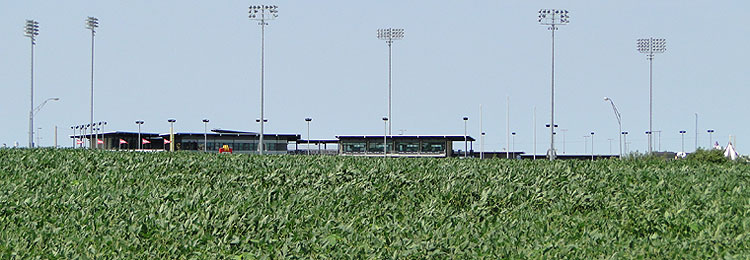
Location
Better known, and generally touted, as being in Sarpy County, Werner Park is situated in former farmland near Highway 370 in an unincorporated part of the county, with plans for the land to one day be annexed into the nearby county seat city of Papillion, which is the city of record for the ballpark's official address. An even 19 miles northeast from 12356 Ballpark Way in Papillion is TD Ameritrade Park in Omaha, which opened the same year as Werner Park to primarily serve as the home of the College World Series each June. While the downtown Omaha ballpark is surrounded by all the big city stuff you'd expect, Sarpy County's stadium looks out upon land upon which corn is still grown, with soybean fields and prairie grass a very common sight on the site for which the master plan is to build homes, hotels, restaurants, etc. The etcetera even includes plans for an indoor ice rink to be included in the area that will be known as Pennant Place. Werner Park was the first planned piece to open in Pennant Place and will serve as the anchor for all that is to come.
Getting There [map it]
Werner Park is just under 3 miles from I-80 and is easy to get to from the Interstate. Just take exit #439 then travel east on Highway 370. After 2.6 miles, turn left onto 126th Street and you'll see the ballpark ahead on the right. The actual distance from I-80 to the ballpark's parking lot entrance is 2.8 miles and good signage along the way ensures that Werner Park is easy to find.
Parking
Parking is plentiful and free, cheap or modestly priced depending on where you park. As would be expected, free parking is furthest from the ballpark, and it's in unpaved lots behind left field. To park for free, just bypass the paid and paved parking lot entrances off of 126th Street and turn right on Lincoln Road. From that road you enter the gravel lots on your right. Space there isn't guaranteed however, as they'll be gone 20 minutes or so before game time on good crowd days (an attendance of more than 6,500). The biggest amount of available parking is classified as general. General parking is just $2 and it makes up the majority of the big parking lots that span the ballpark's left side. Parking lot gates 2 & 4 are the designated entrances for general parking. Gate 3 is the entrance for VIP parking, a $5 option that will put you as close as you can possibly park to Werner Park's main entrance gate and box office, which are both behind home plate.
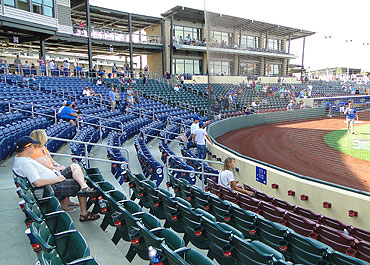 |
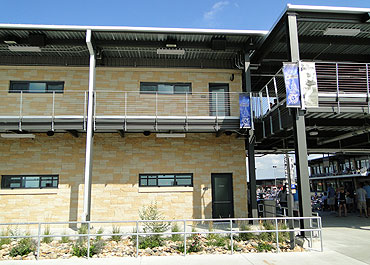 |
| Limestone -- lots of it -- all mined in Nebraska is found throughout the ballpark, which has multi-colored seats in its grandstand. The green, blue and maroon seats (left) are quite the color contrast from the golden-hued limestone, which was most notably used to build the two-story suite structures (right) that are along the first and third baselines. |
Features
The playing field has a classic look in the infield, thanks to a simple dirt strip, and a quirky one in the outfield, where the wall curves inward in right field and is angular in left field. While the concave and jagged outfield fence is a noticeably contrived design seen fairly frequently in today's modern retro-styled ballparks, the dirt path between the pitcher's mound and home plate is something that was commonplace long ago but is rarely seen in ballparks nowadays.
A 24-foot tall carousel purchased from Universal Studios in Orlando, FL is the featured attraction in the pay-to-play family fun zone that's found on the left field corner concourse. Designed to entertain children aged 3-12, the 6,500-square-foot activity-filled fun zone also has tent-covered permanent playground equipment and numerous inflatables, which are deflated after each game.
Left-center field is home to a few of the ballpark's most notable amenities. It's where, from left to right, a bar, basketball court, and whiffleball field can be found. The Downdraught Bar is beneath the ballpark's scoreboard and serves beer, liquor and wine selections. Next to it is a basketball court, which is less than half-court in size. To its right is a much bigger whiffleball field, where the bases in the all-dirt infield are 45 feet apart and right field is very much downhill from home plate.
Warren Buffett, one of the world's richest men, was a minority owner of his hometown baseball team from 1991 until 2012 and is the inspiration for the Buffett Boardroom, a quite visible meeting room that looks out on the third base concourse. The glass-walled boardroom is just that -- a simple boardroom that contains a table with office chairs around it. The Buffett Boardroom has a capacity of 20 people but it's not accessible to the public. Instead, it's set aside for exclusive use by the Storm Chasers front office. The ballpark's boardroom is 18 miles from Omaha's Kiewit Plaza, the location of the headquarters of Berkshire Hathaway Inc., the holding company that made Buffett a multi-billionaire.
The bullpens are stacked alongside the right side of the batter's backdrop. Omaha's bullpen is elevated above the visitors', which is at field level. Simple chain-link fencing is all the separates the berm from the bullpens, so they are quite fan-friendly when it comes to accessibility.
Flames burst from mini cauldrons on both sides of the batter's backdrop in center field whenever the Storm Chasers win a game or hit a home run. The fiery display from the "Batter’s Eye Flames" also occurs at the start of the game.
An interesting sight to see after the game is the procession of players from both teams heading to left field, where a ramp near the foul pole leads from the playing field to the clubhouses, which are behind the concourse in left field. Fans can stand on a metallic bridge there as the players pass underneath.
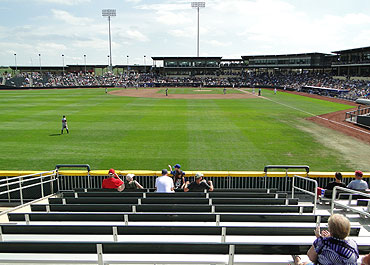 |
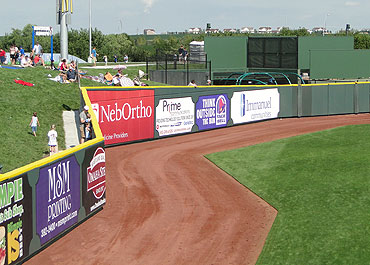 |
| The Home Run Porch overlooks the action in left field, where the fence zigs and zags at odd angles. The fence is irregular in right field too, but it curves inward there. Berm seating is behind the outfield wall on each side, except for where the bleacher-filled Home Run Porch is. |
Ballpark History
That the Omaha Storm Chasers don’t actually play in Omaha has everything to do with a decision by that city in 2008, when plans to build a replacement for Rosenblatt Stadium were announced to satisfy the NCAA.
Rosenblatt Stadium (est. 1948) had been home to the College World Series since 1950 and the Kansas City Royals’ Triple-A team since 1969, but a combination of a bunch of things, age included, meant a new ballpark was needed to keep the CWS in Omaha long-term.
Keeping the then named Omaha Royals in Nebraska’s largest city was a hoped for byproduct of the new ballpark plan announced on February 27, 2008, but what came to be called TD Ameritrade Park wasn’t designed to be the intimate, family-friendly minor league ballpark that the O-Royals wanted. It did, however, secure the rights to host the CWS for another 25 years, which was Omaha's primary goal.
So instead of playing second fiddle in a 24,000-seat stadium in downtown Omaha, the Royals set their sights on getting a smaller ballpark in the Omaha suburbs, where one could be built to suit for the team. Sarpy County formally came into play after a chance encounter at the Memphis airport in December 2007 between the Royals’ president, Alan Stein, and a county administrator named Mark Wayne. The two got to talking in Tennessee and a year later a Memorandum of Understanding would be signed between the two parties that the men represented to build a baseball stadium that would "serve as the anchor of an attractive, vibrant multiple-use family entertainment destination.''
The MOU was announced on December 3, 2008, a contract guaranteeing the ballpark would be built by the county and used by the Triple-A team was signed on March 17, 2009, and on June 1, 2009 the site for the ballpark was chosen.
Schewe Farms was the site in Sarpy County that was chosen, and as its name suggests it was the most rural of the three finalists. The two runner-up locations were in Bellevue and LaVista. They lost out to a 300-acre parcel of farmland where corn stalks and soybean plants have been replaced by Pennant Place, a still in the process of being built live, work and play community that features Werner Park and its parking lots, which collectively occupy 31 acres in the southwestern portion of the site that is just west of Papillion city limits.
Werner Park was the first thing to open in Pennant Place, the multiple-use family entertainment destination envisioned by the MOU, when on April 8, 2011 a game between two local high school teams actually christened the ballpark. The Papillion-LaVista South Titans beat the Papillion-LaVista Monarchs, 2-0, before an estimated 2,500 fans.
The following weekend, the Omaha Storm Chasers, renamed as such on November 15, 2010, officially began play in their new home, although their inaugural home game, scheduled for April 15, was postponed due to weather, which seemed somewhat apropos given the team’s new name.
And so, despite what the ballpark’s dedication plaque reads, April 16, 2011, and not the April 15th date that is etched into bronze, ended up being the official Opening Day for Werner Park.
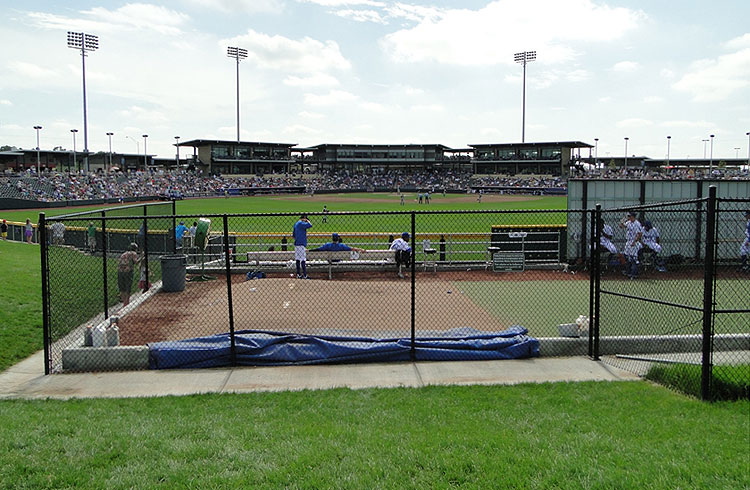
Werner Park Facts, Figures & Footnotes
Construction cost: $29.405 million
Financing: Sarpy County issued bonds totaling $27,055,000 and the Omaha Storm Chasers contributed $2.35 million. The county's bond debt will be primarily paid off through these means: rent collected from the Storm Chasers, which is estimated to cover roughly one-third of the debt payments; all sales taxes generated at the ballpark plus a portion of the sales and hotel taxes generated from stores and hotels near the ballpark; a 50-cent ticket surcharge on selected seats, which is projected to bring in $3 million over the 25-year lifespan of the bonds.
The entire cost of getting the ballpark built is estimated to be $36 million, which includes related infrastructure costs such as the new roads needed to access it.
Architect: DLR Group
Construction manager: The Weitz Company
Built on a 31-acre site that was donated by Roger Langpaul, the commercial real estate developer for Pennant Place, a mixed-use development that will eventually surround most of the ballpark.
Ceremonial groundbreaking took place on August 12, 2009, although construction didn't actually begin until October 9, 2009.
Naming rights: Locally-based Werner Enterprises, a major trucking and transportation company, pays $305,000 annually in a 5-year deal that was announced on November 11, 2010. As the crow flies, the world headquarters for Werner Enterprises are less than two miles from the ballpark they sponsor and have an option for a five-year renewal on when the original deal expires following the 2015 season.
Owned by Sarpy County and operated by the Omaha Storm Chasers.
Per the 25-year lease agreement the team signed with the county, the Storm Chasers pay $450,000 annually in rent and that amount will rise with inflation after five years. However, much of the team's lease payment is offset with naming rights revenue, as the Storm Chasers get to keep the first $300,000 of that yearly fee before having to split it 50/50 with Sarpy County. Based on that formula and the original five-year naming rights agreement, the county receives just $12,500 of the $1,525,000 that Werner Enterprises is paying.
Has 6,434 fixed seats in the main grandstand, and all of them have a cup holder. There are 26 sections in the grandstand and its seats are colored based on their box office designation. Blue seats are in the Club Area, which are the three sections (112-114) behind home plate; the first two rows of every non-Club section are maroon and they signify the Field Box Seats; all other seats are green and they are considered regular Box Seats.
Two sections of bleachers are in left field and they have a combined capacity of 320. Referred to as the "Home Run Porch," the left field bleacher seats have backs.
Replaced the biggest ballpark in minor league baseball. Werner Park's official capacity is just 39% of its predecessor, Rosenblatt Stadium, which could hold 23,145 and was the minors' only ballpark with a capacity above 20,000 when it closed.
Four seats from Rosenblatt Stadium were preserved and placed on the first base concourse, which is named Rosenblatt Way. The seats are bolted into the concourse and are easy to spot, in part because of their bright red color.
The third base side concourse is named Bob Gibson Boulevard after the Hall of Fame pitching legend who was born (1935), raised, went to college (Creighton University) and played parts of three minor league seasons (1957-59) in Omaha. Panels and banners on the third base concourse show pictures of Gibson as a Cardinal and Blue Jay, his major league and collegiate teams.
The entire concourse, which completely circles the field, is approximately 0.34 miles long and has open views of the field from everywhere except for the portions of it that are behind the two suite buildings.
Has 15 suites. One is at field level down the left field line, where a dugout-style suite can hold 18 fans. The other 14 suites are in a pair of identical-looking two-story office building-like structures that are on the first and third base concourse. Those 14 suites vary in capacity, holding either 18 or 36 people, although all have 12 balcony box seats, and each is named after a baseball legend or someone associated with the Omaha and/or Kansas City Royals. The suites on the first base side are named for George Brett, Dennis Leonard, Jackie Robinson, Johnny Rosenblatt, Paul Splittorff and John Wathan. The third base suites are named for Richie Ashburn, Wade Boggs, Jesse Cuevas, Dick Howser, Denny Matthews, Jack McKeon, Frank Robinson and Frank White.
The scoreboard is in left-center field and is a three-parter when it comes to panels that display information. From top to bottom, there's a 31' x 16' video board, a 45' x 10' line scoreboard, and a 29' x 4' message board. Atop them all is the 42' x 14' Werner Park sign, a size chosen to approximate that of the typical semi-truck trailer used by Werner Enterprises.
Official Ballpark Firsts
First game: On April 16, 2011, the Omaha Storm Chasers beat the Nashville Sounds, 2-1, in front of 6,533 fans
The first game was actually scheduled for April 15, 2011, but a mixture of wind, rain and snow delayed Opening Day by a day.
There were multiple ceremonial first pitches, but the final one thrown was by George Brett to fellow Hall of Famer, and Omaha native, Bob Gibson.
Other official ballpark firsts (all of which occurred on 4/16/11, unless noted):
| Pitch | Batter | Hit (single) | Home Run (4/17) | Winning Pitcher | Losing Pitcher | Save |
| Danny Duffy | Eric Farris | David Lough | Taylor Green | Jesse Chavez | Manny Parra | Louis Coleman |

|











